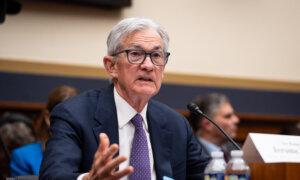‘If you are in the stagflation camp, these data aren’t confirming your thesis,’ one market expert said.
Wholesale inflation in April recorded the sharpest drop since the onset of the COVID-19 pandemic, signaling that U.S. tariffs have yet to impact consumers.
Last month, the producer price index (PPI)—a gauge of prices for goods and services paid by businesses early in the supply chain—fell by 0.5 percent, down from the upwardly adjusted zero percent recorded in March.
The consensus forecast suggested a 0.2 percent increase.
Core wholesale prices, which omit the volatile energy and food categories and are considered a more accurate inflation predictor, also declined by 0.4 percent in April. This was down from March’s upwardly revised 0.4 percent increase and lower than economists’ expectations.
Core PPI inflation eased to 3.1 percent from 4 percent year over year, in line with market watchers’ projections.
Economists monitor the PPI closely as it can signal pipeline inflation. The Federal Reserve watches producer prices closely as they contribute to the personal consumption expenditure (PCE) price index, the central bank’s preferred inflation report.
Later this month, PCE inflation is expected to come in at 2.2 percent, according to the Cleveland Fed’s Inflation Nowcasting model estimate.
The annual inflation rate slowed to a smaller-than-expected 2.3 percent, the lowest level since February 2021. Core CPI inflation was unchanged at 2.8 percent.
Despite growing stagflation fears—an economic climate of higher prices, rising unemployment, and slowing growth—these numbers should dissipate worries, said Jamie Cox, a managing partner for Harris Financial Group.
“If you are in the stagflation camp, these data aren’t confirming your thesis. While growth is slowing, disinflation remains intact,” Cox said in a note emailed to The Epoch Times.
Inflation Watch
While the latest influx of data suggests that higher inflation has yet to materialize, a chorus of economists says that potential adverse effects of tariffs could begin to show up in the hard data in the second half of 2025.
Other economic observers say that inflation will likely reaccelerate, though the outcome could be less dire than initially reported.
“Inflation looks likely to pick up in the second half of 2025 as businesses pass on the cost of tariffs,” Bill Adams, chief economist at Comerica Bank, said in a note emailed to The Epoch Times.
“But after cuts to the tariff rates applied to most imports, the effect will be smaller than it appeared a few weeks ago.”
Tariff-related price pressures might be more “manageable” than expected for businesses and consumers, Adams noted.
Echoing the sentiment of Federal Reserve Chair Jerome Powell, they said tariff-driven price pressures could be temporary.

A customer shops at a Walmart store in Houston, Texas, on Aug. 4, 2021. Brandon Bell/Getty Images
“It should be transitory, provided that the trade war de-escalates, the Fed does not cut rates prematurely and/or its independence is not called into question,” they wrote.
“All of this would allow household inflation expectations to fall from their current high levels and prevent them from becoming self-fulfilling.”
A plethora of consumer surveys have highlighted households’ growing consternation surrounding a possible inflation revival.
The University of Michigan’s April Consumer Sentiment Index highlighted the one- and five-year inflation outlooks climbing to 6.5 percent and 4.4 percent, respectively.
These concerns could be justified based on recent statements from Corporate America. Several major companies have said they plan to raise prices in the coming months amid the blowback from tariffs.
Walmart, which reported a drop in first-quarter profits in its latest earnings report, says it will have to absorb tariff costs.
Last month, tool maker Stanley Black & Decker said it increased prices by high single digits across U.S. retailers and plans to introduce another round of hikes later this year.
“With that in mind, we implemented an initial price increase in April and notified our customers that further price action is required.”
What This Means for the Fed
The wave of positive economic data has prompted investors to push back their interest rate forecasts.
With the higher-than-expected retail sales data in April—sales rose by 0.1 percent, and March numbers were revised higher to 1.7 percent—monetary policymakers will likely sit on the sidelines, says Jeffrey Roach, chief economist for LPL Financial.
“Steady consumer incomes should support discretionary spending, adding to the likelihood that the Fed can stay on hold as long as growth prospects remain stable,” Roach said in a note emailed to The Epoch Times.
In prepared remarks on May 15, Powell said that long-term interest rates will likely be higher amid policy uncertainty and economic changes.
“Higher real rates may also reflect the possibility that inflation could be more volatile going forward than in the inter-crisis period of the 2010s,” Powell said at the Thomas Laubach Research Conference in Washington.
“We may be entering a period of more frequent, and potentially more persistent, supply shocks—a difficult challenge for the economy and for central banks.”
Original News Source Link – Epoch Times
Running For Office? Conservative Campaign Consulting – Election Day Strategies!


